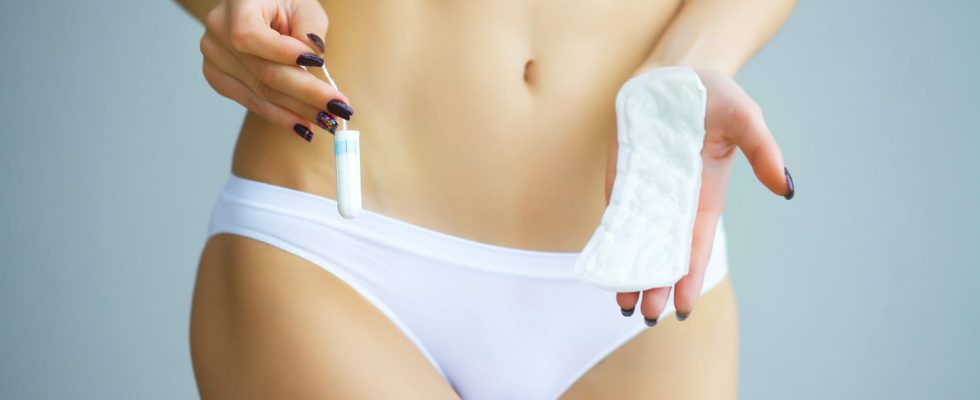From puberty to menopause, a woman will have an average period 450 times during her lifetime. Towels, menstrual panties, tampons, cups… What protection should you choose depending on your body type? His bleeding?
From puberty to menopause, A woman will have an average of 450 periods during her lifetime. During this period which lasts approximately five days and repeats every 20 to 40 days, women have the choice of their protection: sanitary napkins, tampons, menstrual panties, cup… “The main thing is to choose what suits us best” immediately defends Dr. Odile Bagot, medical and obstetrician gynecologist. What are the different periodic protections? What are their advantages and their disadvantages?
Disposable sanitary napkins
Disposable sanitary tape is undoubtedly the best-known hygienic protection. The sanitary napkin is a protection external periodic which attaches to the panties. Towels of all sizes adapt to all body types. By flowing outside the vagina, the blood can take an unpleasant smell, It is therefore recommended to practice good hygiene and change your protection regularly. It is difficult to know the exact composition of sanitary napkins, but they are sometimes suspected of contain various chemicals hazardous to health such as chlorine or dioxin. However, they are now available in an organic version. “THE toxic shock does not only concern tampons, women can suffer from it while wearing sanitary napkins“recalls the gynecologist.
Washable towels
“Ecological alternative disposable sanitary napkins, washable napkins are not not the most comfortable means of protection” admits Dr. Bagot. They are mainly made of natural materials (cotton) and available in an organic version. “You must have a washing facilities available and it is not very optimal in terms of practicality” adds the expert. They are changed every 4 hours on average.
Menstrual panties
“Period panties are the option the most comfortable, clean, ecological and economical“admits the gynecologist.”I have very good feedback from my patients regarding menstrual panties.” It is made up of three technical layers of super absorbent materials placed at the bottom of the panties. The menstrual panties have a absorption equivalent to three or even five tampons.
The tampons
With or without applicatorsanitary tampons help absorb menstrual blood directly into the vagina. Invisible, they allow you to feel totally free to move and allows you to go to the swimming pool or the beach without discomfort. They are easy to put on and take off, especially those with applicators. “The use of tampons, from a very young age, allows know your body and reduce the risk of vaginismus” underlines Dr Bagot. It is recommended to change tampons very regularly because bacteria can develop quickly within this sensitive cavity which can cause, in very rare casesA toxic shock syndrome. “If we change our tampon carefully every 3/4 hours we run no risk” qualifies the specialist. As with disposable sanitary napkins, the composition of tampons is debated because some contain traces of chemicals harmful to mucous membranes. We now find in organic version.
Menstrual cups or “cups”
Looking like a small funnel, the menstrual cup in medical silicone inserts into the vagina like the tampon and allows the menstrual flow to be collected. It collects blood flow but without drying out the vaginal flora and can stay in place for 12 hours approximately before being removed and cleaned. It’s a healthy and economical alternative to tampons which allows the practice of sport and swimming pool without inconvenience. He is essential to sterilize your menstrual cup regularly to prevent the proliferation of bacteria. “Not always easy to insert, you need patience to find the right technique. You have to know your body well. In case of heavy periods, the menstrual cup is not recommended” concedes the gynecologist. “The menstrual cup also imposes logistical constraints; it is essential to have something to clean it on hand.continues Dr. Bagot. Concerning the concomitant use of the cup and the IUD, it is possible and does not cause a suction effect as some people seem to believe. However, if you grab the whole cup and not just the end on purpose, it is possible to tear out your IUD at the same time”.
Instinctive flow
The Instinctive Flow was born at the initiative of a movement of activist women who advocate the total absence of hygienic protection. It consists of contracting the perineum during menstruation and release to “flush” the blood directly into the toilet.
“To practice instinctive flow, you must have a muscular perineum that we control, favor black underwear and not have too heavy periods” underlines our expert.
Thanks to Dr Odile Bagot, medical gynecologist and obstetrician.
